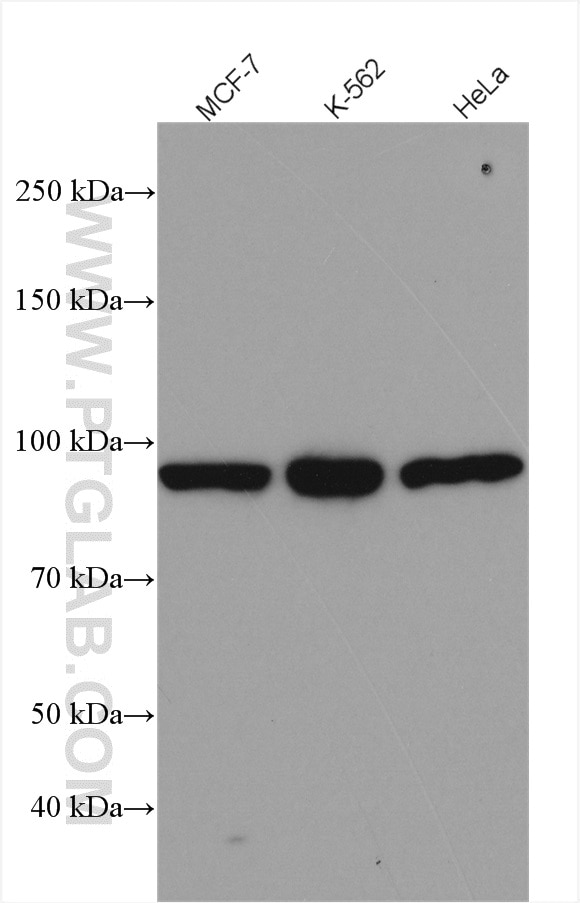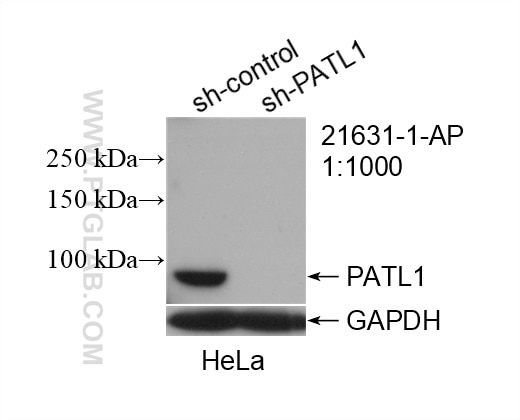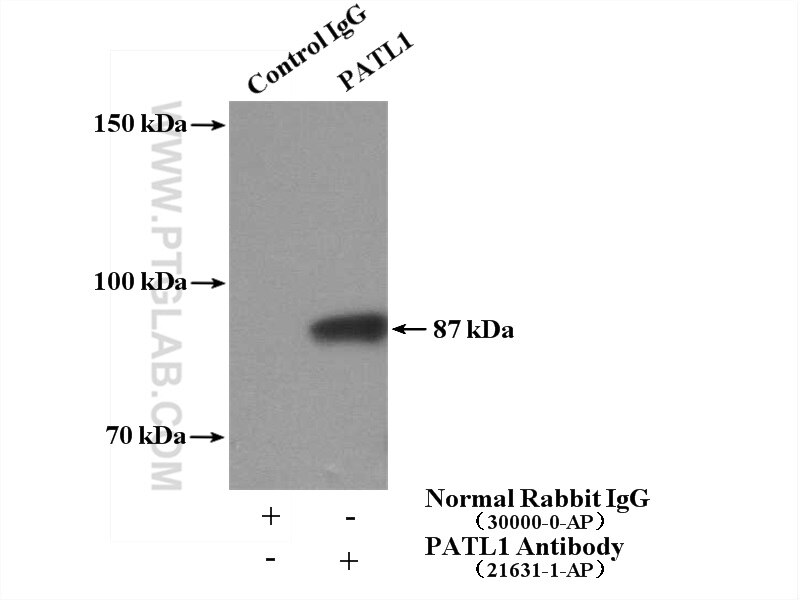Tested Applications
| Positive WB detected in | MCF-7 cells, HeLa cells, K-562 cells |
| Positive IP detected in | K-562 cells |
Recommended dilution
| Application | Dilution |
|---|---|
| Western Blot (WB) | WB : 1:500-1:2000 |
| Immunoprecipitation (IP) | IP : 0.5-4.0 ug for 1.0-3.0 mg of total protein lysate |
| It is recommended that this reagent should be titrated in each testing system to obtain optimal results. | |
| Sample-dependent, Check data in validation data gallery. | |
Published Applications
| WB | See 1 publications below |
Product Information
21631-1-AP targets PATL1 in WB, IP, ELISA applications and shows reactivity with human samples.
| Tested Reactivity | human |
| Cited Reactivity | human |
| Host / Isotype | Rabbit / IgG |
| Class | Polyclonal |
| Type | Antibody |
| Immunogen |
CatNo: Ag16247 Product name: Recombinant human PATL1 protein Source: e coli.-derived, PGEX-4T Tag: GST Domain: 278-627 aa of BC109038 Sequence: LQSTDPYLDDFYYQNYFEKLEKLSAAEEIQGDGPKKERTKLITPQVAKLEHAYKPVQFEGSLGKLTVSSVNNPRKMIDAVVTSRSEDDETKEKQVRDKRRKTLVIIEKTYSLLLDVEDYERRYLLSLEEERPALMDDRKHKICSMYDNLRGKLPGQERPSDDHFVQIMCIRKGKRMVARILPFLSTEQAADILMTTARNLPFLIKKDAQDEVLPCLLSPFSLLLYHLPSVSITSLLRQLMNLPQSAATPALSNPHLTAVLQNKFGLSLLLILLSRGEDLQSSDPATESTQNNQWTEVMFMATRELLRIPQAALAKPISIPTNLVSLFSRYVDRQKLNLLETKLQLVQGIR Predict reactive species |
| Full Name | protein associated with topoisomerase II homolog 1 (yeast) |
| Calculated Molecular Weight | 770 aa, 87 kDa |
| Observed Molecular Weight | 87 kDa |
| GenBank Accession Number | BC109038 |
| Gene Symbol | PATL1 |
| Gene ID (NCBI) | 219988 |
| RRID | AB_2935454 |
| Conjugate | Unconjugated |
| Form | Liquid |
| Purification Method | Antigen affinity purification |
| UNIPROT ID | Q86TB9 |
| Storage Buffer | PBS with 0.02% sodium azide and 50% glycerol, pH 7.3. |
| Storage Conditions | Store at -20°C. Stable for one year after shipment. Aliquoting is unnecessary for -20oC storage. 20ul sizes contain 0.1% BSA. |
Background Information
Patellin1 (PATL1) is a human homolog to yeast P body component Pat1, localizes to P bodies and is required for P body formation. Furthermore, Pat1 is the only decapping activator protein that, besides interacting with deadenylated mRNAs, also binds to eIF4G-, eIF4E- and Pab1p-associated polyadenylated mRNA and locates to polysomes.
Protocols
| Product Specific Protocols | |
|---|---|
| IP protocol for PATL1 antibody 21631-1-AP | Download protocol |
| WB protocol for PATL1 antibody 21631-1-AP | Download protocol |
| Standard Protocols | |
|---|---|
| Click here to view our Standard Protocols |
Reviews
The reviews below have been submitted by verified Proteintech customers who received an incentive for providing their feedback.
FH Aditya (Verified Customer) (10-08-2024) | okay
|








